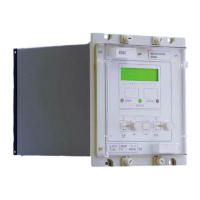Manual
KVCG202/EN M/H
6. MEASUREMENT, RECORDS AND ALARMS
6.1 Measurement
The measured voltage (Vbc) and phase A current values (
IL) and (Ic) are available in
real time. The rolling average calculation is used to provide a stable displayed reading of
the measured values obtained from the sampled waveforms. It is achieved by averaging
the last eight measured or calculated values.
6.1.1 Currents
Current is measured once per power frequency cycle and Fourier is used to extract the
fundamental component. Measurements are made for line (
IL) and circulating currents
(
Ic). These values are stored in cell locations 0203 and 0204 respectively.
6.1.2 Voltages
The line voltage (Vbc) is measured directly and stored in menu location 0201.
The regulated voltage (Vreg) is calculated by subtracting the line compensation and
circulating current compensation voltages from the line voltage (Vbc). This voltage is
compared with the reference voltage (Vs) and the deviation in the regulated voltage is
adjusted automatically by actuating the tap changer mechanism. The regulated voltage
(Vreg) is stored in cell location 0202.
6.1.3 Frequency
The sampling frequency of the A/D converter is synchronised to the power system
frequency when there is a signal of sufficient strength to reliably make a frequency
measurement. In the absence of a signal to frequency track the sampling frequency
defaults to the power frequency setting in menu cell 0009. The measured frequency
defaults to the power frequency setting when the current and voltage is zero. The
displayed frequency measurement will also be the sampling frequency, but in this case it
will read 0 when the frequency tracking stops. The measured frequency is stored in cell
location 0206.
6.1.4 Power factor
The real and apparent power is calculated from the measured load current (
IL) and line
voltage (Vbc) quantities. These are made available in the form of magnitude and phase
information or as quadrature fourier vectors (
Icos (_vect and Isin (_vect) as illustrated in
the diagram below.
Figure 32:
‘Real’ power is then calculated from fourier Vbc
Icos (vector and the fourier IL Icosφ. The
apparent power is calculated from Vbc and
IL magnitudes.

